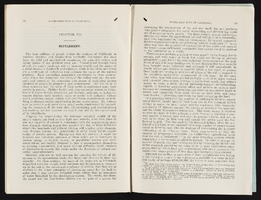Search the Special Collections and Archives Portal
Search Results
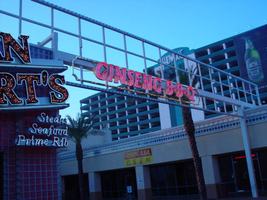
Photographs of Ginseng BBQ signs, Las Vegas (Nev.), 2002
Date
Archival Collection
Description
Site address: 3765 S Las Vegas Blvd
Sign details: Down the driveway created between the Fatburger and Walgreen's structure is a slightly larger lot, which is home to the Ginseng BBQ establishment. The signage is a gateway, banner structure which leads to this slightly larger lot. It is visible standing directly in front of the Fatburger sign, looking east down the alley.
Sign condition: Structure 3 Surface 3 Lighting 3
Sign form: Pylon
Sign-specific description: Attached to the section of the Fatburger building which houses the entrance to the Alan Albert's, and stretches across to the building which houses Walgreen's is a sign which is comprised of a horizontal overhead structure of steel beams, forming a lattice work or skeleton of an entrance. The top and bottom edges are white raceways with incandescent bulbs. Placed awkwardly along the bottom portion of the skeleton is a border of gold polished raceways with incandescent bulbs. There is no backing to the border, so it is simply an edge and nothing more inside this border consisting of the structure of the sign. The top and bottom edges of the structure are lined with incandescent bulbs. "Ginseng BBQ" is spelled in gold channel letters painted white on the inside, with red neon in the interior. The letters are all caps and centered inside the border. The sign faces west. The actual establishment is further east. through the gateway where a slightly larger lot is located, on the north face of the Walgreens side of the complex.
Sign - type of display: Neon; Incandescent
Sign - media: Steel
Sign animation: Chasing, flashing, oscillating
Notes: The text, which resides on the southern wall and reads "Casino," is filled with incandescent bulbs that all illuminate at the same time, and oscillate. They then shut off at the same time, and then repeat. The raceways of incandescent bulbs chase each other while the neon, which surrounds the back lit, plastic, screens on this wall flash on then off. The bottom two raceways sandwiching the reflective panel chase from left to right, while the remainder of the raceways surrounding the signs, run right to left. The incandescent bulbs on the pylon chase each other gracefully up the length of the pylon. The animation is patterned so as to appear as if a section of several bulbs are pulsing its way up the towers, hugging the edge of the bulbous tops. The raceways continue around the east face of the building. The umbrellas in the plaza behind the pylon, also are animated with incandescent bulbs chasing each other downward along the raceways.
Sign environment: The environment which the Ginseng BBQ's establishment shares is dictated by its neighbors of Walgreen's and Fatburger. The small enclosure of a lot, which is in front of the store, follows after passing underneath the main logo text banner for the restaurant. It is hidden among the various neighboring businesses, being protected by the larger structure in front of it.
Sign manufacturer: Vision Sign
Sign - thematic influences: No real theme surrounds the signage other than it appears that it was pieced together from various other pieces of signage. The white, steel skeleton appears as if it was there previously, and the Ginseng sign was attached later. The theme that it does fit into is the small eateries which pop up among the strip malls and small shopping centers along the strip. It is also one of two different Ginseng BBQ establishment.
Surveyor: Joshua Cannaday
Survey - date completed: 2002
Sign keywords: Chasing; Pylon; Neon; Incandescent; Steel
Mixed Content
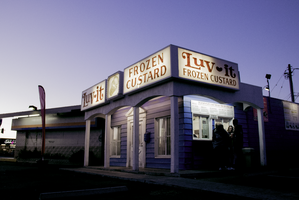
Photographs of Luv-it Frozen Custard stand, Las Vegas (Nev.), January 27, 2017
Date
Archival Collection
Description
Site address: 505 E Oakey Blvd
Sign owner: Brittany and Brandon Tiedemann
Sign details: Luv-It Frozen Custard has been a Las Vegas dessert shop since 1973. They specialize in their "shakes, cones, malts, and hard packs to go." The same family, the Tiedemann's, have been operating the business for four generations. The great-grandmother of the family who opened this modest frozen custard stand originally worked at another famous frozen custard shop called Leon's in Milwaukee, WI. She brought her desire to make frozen custard to Las Vegas and made her own signature flavors. They have been using the same vendors and products to create their delectable ever since they opened. They say the only thing that has changed since they opened is "a new generation of the family and a new color for our building."
Sign condition: 4, the sign is in very good condition. However, the red paint in the letters has faded away slightly.
Sign form: Fascia, Backlit
Sign-specific description: The sign has a very modest design. The signage when looking at the front facade of the building is broken up into three different sections. The first section on the left hand are the words "Luv It" in red, serif style font and a small red heart between the two words. These words are up against a plain white background. Next to that is a small square sign that has a painted vanilla custard cone on it, also with a white background. The sign next to that reads "Frozen Custard" in the same shade of red as the "Luv It" sign and has a white background as well. On the right side of the building over the walk-up window is another sign that reads "Luv It Frozen Custard," which appears to be a combination of the "Luv It" and "Frozen Custard" signs on the front of the building.
Sign - type of display: Backlit
Sign - media: Plastic
Sign - non-neon treatments: Paint
Sign environment: The environment for this humble frozen custard stand straddles Las Vegas Boulevard and a residential neighborhood nearby. It resides near other popular properties along Las Vegas Boulevard as well, such as: Viva Las Arepas, Art of Flavors, Dino's Lounge, and many wedding chapels. It also sits fairly close to John S. Park Historic Neighborhood.
Sign - date of installation: 1973
Sign - thematic influences: The sign looks old fashioned today because they had it ever since they opened. It is a modest sign to reflect the modest business. The element of the sign that reflects back to the business is the frozen yogurt cone portion of the sign that tells you what the business is for.
Sign - artistic significance: This sign uses a symbol to articulate what the business serves. This has been a popular technique for businesses because it is easy for motorists and pedestrians to see what the business is for without having to read any other text.
Survey - research locations: Luvit website
Survey - research notes: https://lasvegassun.com/news/2009/sep/16/sketchy-neighborhood- bites-back/
Surveyor: Lauren Vaccaro
Survey - date completed: 2017-08-25
Sign keywords: Fascia; Backlit; Plastic; Paint
Mixed Content
Carol Harter oral history interview
Identifier
Abstract
Oral history interview with Carol Harter conducted by Claytee D. White on June 18, 2021 for the Boyer Early Las Vegas Oral History Project.
Carol Harter is the longest-serving President of UNLV, from 1995 until 2006. The campus experienced unprecedented growth during that time, including the addition of a new, very large library. Harter grew the campus from 19,000 to 28,000 students, added 23 new or completely renovated buildings to the campus, and with a student-centered focus, added more than 100 new degree programs. Two professional schools, the Dental School and Boyd School of Law, added greatly to the prestige and academic Top Tier status of UNLV.
Her partnership with Glenn Schaeffer, former president of the Mandalay Resort Group, assisted in the early work of the Black Mountain Institute (BMI) Modern Letters program. BMI is an international think tank dedicated to advancing literary and cross-cultural dialogue. This was an important goal to Harter and Schaeffer, who were both literature majors. Harter also discusses many community members who made an impact on UNLV including Joe Crowley and Dr. Juanita Fain.
Archival Collection
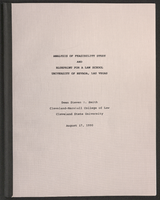
University of Nevada, Las Vegas law school feasibility studies
Date
Archival Collection
Description
Folder contains a study titled "Analysis of Feasibility Study and Blueprint for a Law School, University of Nevada, Las Vegas" by Steven R. Smith, Cleveland-Marshall College of Law, Cleveland State University, August 17,1990 and a second study titled "A Feasibility Study for a Law School at the University of Nevada, Las Vegas" prepared by R. Keith Schwer, PhD, Director, The Center for Business and Economic Research, University of Nevada, Las Vegas, May 29, 1996. From the University of Nevada, Las Vegas William S. Boyd School of Law Records (UA-00048).
Text

Transcript of interview with Chuck Degarmo by Stefani Evans, January 13, 2017
Date
Archival Collection
Description
Southern California native and lifetime resident, landscape architect Chuck Degarmo evokes the Golden State's iconic theme park as he reflects on forty years in the landscape industry and the ways his work has shaped the way Southern Nevada looks and works. It is fitting he would do so. Degarmo forged his professional ties to Las Vegas in 1993, during the heyday of the Las Vegas Strip's "family-friendly" era, when Kirk Kerkorian's MGM Grand Hotel and Casino hired Degarmo's firm, Coast Landscape Construction, to design and landscape their planned 33-acre MGM Grand Adventures Theme Park. In this interview, Degarmo outlines his work history, which draws upon the combined skills of a salesman, an artisan, a problem-solver, and an entrepreneur. Having owned his own firms and worked for industry giants Valley Crest Companies and BrightView Landscape Development, he discusses an array of topics from running union and non-union crews; Tony Marnell and design-build projects; importing plant material into Nevada; the Neon Museum and Boneyard; The Smith Center for the Performing Arts and Symphony Park; Steve Wynn, the mountain at Wynn Las Vegas, and Lifescapes International; the Lucky Dragon; Cosmopolitan, CityCenter, and the Vdara "death ray", and the Southern Nevada Public Lands Management Act (SNPLMA). Throughout, Degarmo articulates his work through the lens of a lifetime Southern Californian whose talent has contributed much to the Southern Nevada landscape.
Text
Hirsch, Charles J., 1912-2002
Accountant Charles J. Hirsch was born in New York City, New York on November 8, 1912. After graduating from New York's Pace University in 1938, with a degree in Accounting and Business Administration, he traveled to Las Vegas, Nevada, where he was employed by the Apache Hotel on Fremont Street. His stay in Las Vegas was interrupted once by a five-year tour of duty with the Air Force Contract Audit Division, where he attained the rank of captain before his release in 1946.
Person
Zunino, Jack W., 1948-2024
Alternate Names
Jack Wayne Zunino was born July 13, 1948, in Elko, Nevada to John Wilson Zunino and Loretta Yvette Hansen. He earned a bachelor's degree in psychology from the University of Utah and a master's degree in landscape architecture and environmental panning from Utah State University. In 1989, Zunino established JW Zunino Landscape Architecture, a firm that became a cornerstone of landscape design in the Southwest.
Person
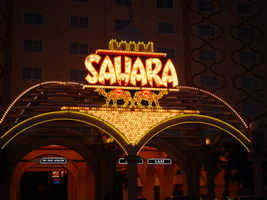
Photographs of Sahara Hotel and Casino signs, Las Vegas (Nev.), 2002
Date
Archival Collection
Description
Site name: Sahara Hotel and Casino (Las Vegas, Nev.)
Site address: 2535 S Las Vegas Blvd
Sign owner: William Bennett
Sign details: The Sahara lies at the northern most end of the survey, on Sahara, and Las Vegas Blvd The Sahara was remodeled in the late nineties to create an entirely new facade utilizing a large pylon, a porte cochere and various independent illuminated signs. On the eastern side of the property another porte cochere is located just west of Paradise Rd. across the street from the Sahara's original pylon.
Sign condition: Structure 5 Surface 5 Lighting 5
Sign form: Pylon; Fascia; Porte-cochère
Sign - type of display: Neon; Incandescent; Backlit
Sign - media: Steel; Plastic
Sign - non-neon treatments: Graphics; Paint
Sign animation: Flashing, oscillating
Sign environment: The Sahara utilizes many of the new elements of Las Vegas to create an environment. The western side of the property facing the strip is composed of a giant pylon, a domed porte cochere, and a roller coaster for the themed attraction incorporated into the property. To the north across Sahara Ave. the Holy Cow casino gives way to the distinctly older and smaller venues on the remaining northern stretch of the strip, while the entire heart of the boulevard lies to the South. Palm trees and various foliage surround winding drives which lead up to the open air dome, fore the circular valet. Along the twisting lanes leading to the parking garage, you can see fiberglass figures riding on camels, and various text signage upon the structures. Walking through the lush surroundings toward the north side of the property, you encounter the giant pylon, being able to walk right up next to it. The roar of the rollercoaster is rather deafening as it zooms right over a pedestrians head, as the signage for the NASCAR gives way to human sight.
Sign manufacturer: Mikhon Lighting and sign
Sign designer: New Pylon: Jack M. Larsen Jr. and Mikhon Lighting and sign
Sign - date of installation: 1996-2000
Sign - date of redesign/move: During the reconstruction which took place between 1996 and 2000, the original pylon was moved east across Paradise Rd
Sign - thematic influences: The theme of the Sahara is definitely linked to the desert theme so often seen throughout Las Vegas history. The name itself is the name of what is probably the most famous desert in the world. Elements of the design give way to this theme with rather heavy-handed iconography. Examples of this include the image of a camel on the pylon and rear porte cochere, as well as the statuary of men riding on camels. The text is the same classic Sahara text seen throughout the properties history, and definite reference the cure and angle of some Arabic writing, but also are linked to shapes seen in the architecture from that region of the world. Other properties which can be linked to this theme in Las Vegas History include, the Dunes, and the Aladdin. The Aladdin and the Sahara also share the trait of being a Vegas icon, revamped to meet the current trends of Las Vegas. The Sahara falls into that trend of being geared more toward the family theme these days, with the addition of the NASCAR Cafe as well as the roller coaster. The other property which incorporates a roller coaster is the New York New York.
Surveyor: Joshua Cannaday
Survey - date completed: 2002
Sign keywords: Flashing; Oscillating; Pylon; Fascia; Porte-cochère; Neon; Incandescent; Backlit; Steel; Plastic; Paint; Graphics
Mixed Content
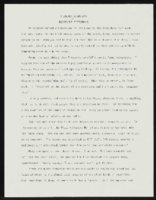
"Suddenly Americans": article draft by Roosevelt Fitzgerald
Date
Archival Collection
Description
From the Roosevelt Fitzgerald Professional Papers (MS-01082) -- Drafts for the Las Vegas Sentinel Voice file. On Black athletes at the 1988 Seoul, Korea Olympics.
Text

